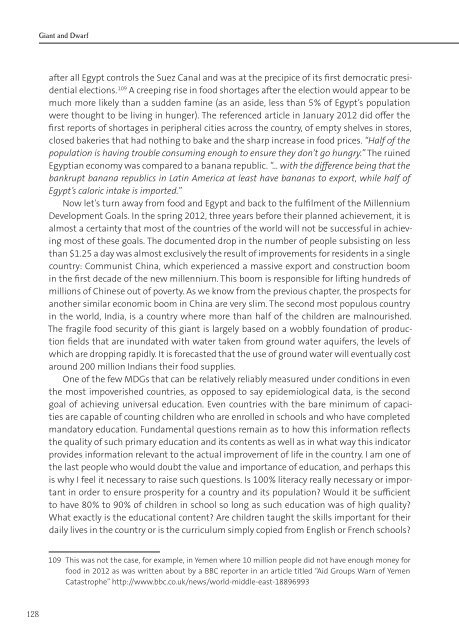Giant_and_Dwarf-FIN
Giant_and_Dwarf-FIN
Giant_and_Dwarf-FIN
You also want an ePaper? Increase the reach of your titles
YUMPU automatically turns print PDFs into web optimized ePapers that Google loves.
<strong>Giant</strong> <strong>and</strong> <strong>Dwarf</strong>after all Egypt controls the Suez Canal <strong>and</strong> was at the precipice of its first democratic presidentialelections. 109 A creeping rise in food shortages after the election would appear to bemuch more likely than a sudden famine (as an aside, less than 5 % of Egypt’s populationwere thought to be living in hunger). The referenced article in January 2012 did offer thefirst reports of shortages in peripheral cities across the country, of empty shelves in stores,closed bakeries that had nothing to bake <strong>and</strong> the sharp increase in food prices. “Half of thepopulation is having trouble consuming enough to ensure they don’t go hungry.” The ruinedEgyptian economy was compared to a banana republic. “... with the difference being that thebankrupt banana republics in Latin America at least have bananas to export, while half ofEgypt’s caloric intake is imported.”Now let’s turn away from food <strong>and</strong> Egypt <strong>and</strong> back to the fulfilment of the MillenniumDevelopment Goals. In the spring 2012, three years before their planned achievement, it isalmost a certainty that most of the countries of the world will not be successful in achievingmost of these goals. The documented drop in the number of people subsisting on lessthan $1.25 a day was almost exclusively the result of improvements for residents in a singlecountry: Communist China, which experienced a massive export <strong>and</strong> construction boomin the first decade of the new millennium. This boom is responsible for lifting hundreds ofmillions of Chinese out of poverty. As we know from the previous chapter, the prospects foranother similar economic boom in China are very slim. The second most populous countryin the world, India, is a country where more than half of the children are malnourished.The fragile food security of this giant is largely based on a wobbly foundation of productionfields that are inundated with water taken from ground water aquifers, the levels ofwhich are dropping rapidly. It is forecasted that the use of ground water will eventually costaround 200 million Indians their food supplies.One of the few MDGs that can be relatively reliably measured under conditions in eventhe most impoverished countries, as opposed to say epidemiological data, is the secondgoal of achieving universal education. Even countries with the bare minimum of capacitiesare capable of counting children who are enrolled in schools <strong>and</strong> who have completedm<strong>and</strong>atory education. Fundamental questions remain as to how this information reflectsthe quality of such primary education <strong>and</strong> its contents as well as in what way this indicatorprovides information relevant to the actual improvement of life in the country. I am one ofthe last people who would doubt the value <strong>and</strong> importance of education, <strong>and</strong> perhaps thisis why I feel it necessary to raise such questions. Is 100 % literacy really necessary or importantin order to ensure prosperity for a country <strong>and</strong> its population? Would it be sufficientto have 80 % to 90 % of children in school so long as such education was of high quality?What exactly is the educational content? Are children taught the skills important for theirdaily lives in the country or is the curriculum simply copied from English or French schools?109 This was not the case, for example, in Yemen where 10 million people did not have enough money forfood in 2012 as was written about by a BBC reporter in an article titled “Aid Groups Warn of YemenCatastrophe” http://www.bbc.co.uk/news/world-middle-east-18896993128


